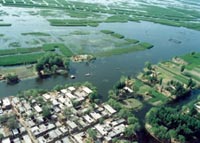
After four decades of droughts, the largest fresh water lake in North China will get a much needed liquid boost.
A new channel to the Baiyangdian Lake is expected to help raise the water level of the "bright pearl" of the Jizhong plain.
The waterlock at the Yuecheng Reservoir was lifted yesterday morning to let water flow into a 450-kilometre canal connecting it with the lake.
The Yuecheng Reservoir holds more than 600 million cubic of water. It can discharge 417 million cubic meters of water above its own flood-control mark into Baiyangdian Lake.
About 160 million cubic meters of water or nearly 40 per cent of total will finally flow into the lake, raising water level of the lake by 2 meters at most.
"We will rehabilitate the damaged ecosystem for people, wild fauna and flora living in and around the lake," said E Jingping, vice-minister of water resources.
Similar water diversion plans were carried out on the Yellow River, the Tarim River, Heihe River and the Zhalong wetland -- a habitat for red-crowned cranes in Northeast Jilin Province.
The new canal marks another attempt to sustainably develop regional water resources, the minister said.
Construction of the canal kicked off last December. Tens of thousands of farmers worked around the clock during the Spring Festival, China's most important holiday for family gathering, said local officials.
It passes through more than 20 counties in Hebei's Handan, Xingtai, Hengshui and Renqiu cities and prefectures. It was built by linking existing local rivers.
"The new water will end Baiyangdian's history of drying up," said Song Enhua, vice-governor of Hebei, adding that the economy around the lake area will also benefit.
Song said he is confident that the extra water can help the lake cast off the dry shadow hanging over it. The area has been plagued by 40 years of droughts.
"The water can help revive tourism, propel fisheries and bulrushes production (a sector that used to account for 40 per cent of China's total output), which are major sources of income for 220,000 locals," the vice-governor said.
Meanwhile, the canal will help refresh groundwater sources in many areas in North China.
The increased water from the canal will help promote agriculture by increasing production levels by 134 million kilograms of grain per year along the canal, an experts estimated.
The most significant benefits of the water diversion will be the rehabilitation of water-related ecosystem around the lake, they say.
Water from the project can ensure good conditions for the growth of water plants, protect the diversities of species of wild fauna and flora, help waterfowl thrive and improve North China's regional climate.
Experts believe the project will also help raise awareness of water-related environmental issues like drought and water pollution.
(China Daily February 17, 2004)
|

